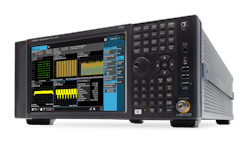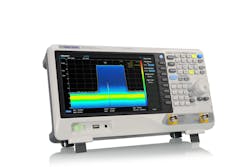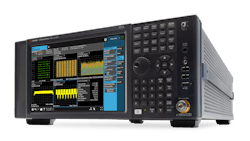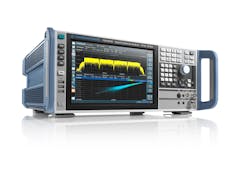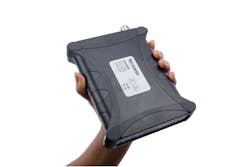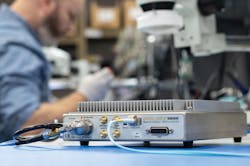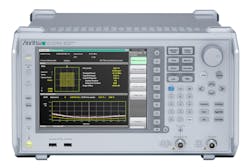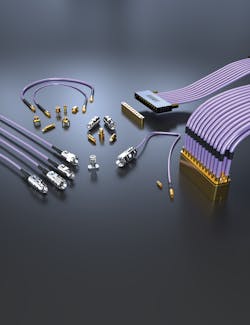Download this article in .PDF format.
Signal and spectrum analyzers are key instruments for measuring the performance of products operating through the RF and millimeter-wave frequency ranges. They address markets extending through low-cost, low-power IoT devices to backhaul and satellite communications. They also have a role to play in radar and military/aerospace test and are available in a variety of form factors, including modular, USB, portable, and benchtop.
Trends
Chonko has also seen interest in flexible instrumentation that can provide traditional spectrum analysis, data demodulation, and device characterization in one box. He said, “The convenience of having an instrument capable of adequately performing a variety of measurements really increases the usefulness of a tool—and if it is portable, even better!”
According to Marty Leeke, market development manager, software and modular solutions division (retired), and Giovanni D’Amore, product marketing operating manager, high-frequency measurement products, both at Keysight Technologies, “The RF/microwave test field is witnessing a profound change related to the diffusion of technologies using RF signals (and in most advanced applications, millimeter-wave signals) to communicate, transfer, and exchange information. It’sLeeke and D’Amore continued, “Aside from the growing communications industry, signal and spectrum analyzers play a pivotal role in radar and defense development. Aerospace and defense market advancements pave the way for more industries to follow—leading industries like internet, wireless communication, satellites, space, and navigation systems. Monitoring the spectrum will become even more important in the next few years when thousands of new low-earth-orbit (LEO) satellites are expected to launch.”
According to Darren Tipton, director of product management, signal and spectrum analysis at Rohde & Schwarz, “We continue to see an increased need for higher frequencies and more bandwidth. The ever-increasing consumer demand for faster and more convenient data usage drives technologies such as 5G and new wideband digital payloads in the satellite industry. Test methodology in these areas are much more focused on modulated testing compared to CW- or VNA-based approaches from just a few years ago.”
“New technologies such as 5G, automotive radar, IoT, and wireless test and measurement solutions greatly increase data usage,” according to Maureen Lipps, product manager, Test & Tools, Newark. “As the current spectrum is getting more crowded, these increases in data usage are driving the market towards spectrum and signal analyzers capable of utilizing higher frequency spectrums (micro and mmWave), which offer greater bandwidth for transmitting large amounts of data.”
Lipps added, “Other trends driving the market for spectrum analyzers are multitasking features and the demand for high-performance portable handheld devices.”
Jose Rodriguez, technical marketing manager at Tektronix, noted that in April the FCC voted to unlock spectrum in the 6-GHz band for Wi-Fi 6E using the latest 802.11ax protocol.2 The move positions Wi-Fi 6E to compete with 5G NR in indoor applications that demand low latency, with detailed cost-benefit analysis required to choose the optimum technology for a given application, said Rodrigues, citing research from Counterpoint.3
Anritsu also sees a trend toward 5G. “Engineers designing and manufacturing UE utilizing emerging technologies, such as those used in 5G and IoT, need test solutions to verify that products are in compliance with the latest industry standards, but also have a flexible, cost-efficient pathway to measure UE based on future requirements,” said a company spokesperson. “Test solutions that have modular platforms to support a variety of applications and have software options for modulation analysis of communications technologies can satisfy this need.”
According to Brandon Malatest, COO, Per Vices Corp., “Signal and spectrum analyzers are becoming increasingly powerful and flexible through the further adoption and integration of software-defined-radio technology. This trend has led to the need for high-performance SDR platforms with high sampling bandwidths, converter resolution, extended tuning range, and a greater number of channels.”
Steve Sandler, managing director at Picotest, a maker of probes and accessories for spectrum measurements, identified a need for more real-time performance and wider bandwidth. “Oscilloscopes are also incorporating more sophisticated spectrum-analysis features, such as Spectrum View from Tektronix,” he said. “These tools provide separate hardware paths for the time domain and frequency domain so that the resolution bandwidth is independent of the time base,” and they also support time-correlated spectrum measurements.
When asked about challenges customers are facing, Sandler said, “Getting a sense of EMI early in the design is a big one.” He added that components such as LNAs, PLLs, and clocks are sensitive to noise, “…and spectrum is the best way to look at it.” Picotest serves applications including low-noise-circuit troubleshooting and optimization as well as jitter assessment, he added.
Challenges
“The two biggest challenges for our customers today are budget and performance,” said Chonko at SIGLENT. “Engineers are facing increasing complexity in design and troubleshooting tasks with some very tight budgetary constraints. They are looking for tools that provide the widest range of uses without compromising measurement integrity at the lowest costs.”
According to Leeke and D’Amore at Keysight, customers in areas extending from wireless communication to aerospace and defense face a variety of issues. “In communications, wireless customers must meet the demand for massive growth in mobile data,” they said. “With more users joining the network every day, and each one wanting faster speeds, higher throughput, and utmost reliability, providers must be able to simulate and monitor these challenging environments to provide the quality needed. As 5G and mmWave markets progress, governing bodies such as 3GPP introduce new standards to meet. Manufacturers must ensure their devices meet expectations of both governing organizations and the everyday consumer, making testing pivotal.”
Leeke and D’Amore continued, “In the defense market, spectrum monitoring allows users to ensure high-capacity links remain secure, keep an eye on radar sensors, and utilize mmWave frequencies for EW sensing, active denial systems, and many more. It has become more important for tests to be repeatable and reliable.”
Lipps also cited cost, saying customers are interested in affordable, portable, rugged handheld analyzers that can be used in the field, particularly to track down interference. “Customers also face problems with interference between the devices that generate RF signals. Given the challenge of characterizing the behavior of RF devices, it is necessary to understand how frequency, amplitude, and modulation parameters behave over short and long intervals of time; therefore, it is crucial for engineers and scientists to be able to reliably detect and characterize RF signals that change over time.”
According to Malatest at Per Vices, “Our customers, like many of those in this market, face challenges associated with performance with specific emphasis on operating frequency, bandwidth, and channel count. Many applications that make use of signal and spectrum analyzers have advanced with respect to their needs and require operation above 6 GHz with 400+ MHz of bandwidth and many independent radio chains (6+).”
“This year, the clear ramp up to mmWave 5G has been a big challenge for many customers,” said Tipton at Rohde & Schwarz. “Converting from conducted testing to OTA testing brings new challenges. Many customers have needed to learn that testing at 3 GHz does not work in the same way as at 28, 39, or 44 GHz. Here, Rohde & Schwarz has acted as a consultant to our customers due to our long experience in testing at such high frequencies.”
According to Maxwell at Rohde & Schwarz, test time represents a key challenge. “As 5G begins to mature, exhaustive testing is underway to verify that these designs work in every condition in order to meet customers’ diverse needs,” he said. “Fast testing is essential to managing capital equipment budgets, in addition to fully characterizing and validating 5G designs and hitting the early market windows.”
Maxwell added that satellite communications also demands higher data rates, which results in higher bandwidths. “We see performance of radar systems advancing in automotive for self-driving vehicles,” he said. “It’s important to equip vehicles that can resolve smaller objects from larger objects for better safety, and this is achieved by using wider bandwidths. Though 5G is barely deployed, it’s time to start considering what’s to follow and what 6G will look like.”
MathWorks addresses signal analysis from a software perspective, as described by Eric Wetjen, product manager, test and measurement products, and Houman Zarrinkoub, product manager, wireless and communications products. “Conformance testing of wireless systems is paramount to ensure maximum fidelity to the standards,” said Zarrinkoub. “In the 5G era, new millimeter-wave frequency bands are being introduced. Distortions and impediments to wireless communication must be analyzed and verified for these frequencies, and new devices like base stations and mobile phones must be built and tested at these frequencies. This, in turn, drives the need for up-to-date application tools for analysis and test.”
Wetjen explained that configuring test equipment and SDRs to validate 5G and other communications signals over the air (OTA) can take too much time and is cumbersome to set up.
“Continuous evolution of communication standards like 5G and Wi-Fi are aiming to address the insatiable need for speed and throughput in wireless networks,” added Zarrinkoub. “To satisfy these needs, new innovative algorithms such as massive MIMO and beamforming are introduced. This, in turn, adds significant complexity to the design of wireless systems.”
Products
SIGLENT’s Chonko pointed out, “We have expanded our standard spectrum-analyzer platform to 7.5 GHz with the new SSA3075X Plus, added two new real-time spectrum analyzers in the SSA3075X-R Series, and also added a 7.5-GHz spectrum and vector network analyzer model, the SVA1075X. All of our analyzers have swept superheterodyne analysis and optional firmware upgrades to provide automatic measurement and signal demodulation,” he said. “The Plus, X-R, and SVA models have distance-to-fault, vector-signal-analysis, and other toolkits to help with more specialized measurements. With each product in these categories, engineers are getting serious measurement performance on a flexible platform that won’t break the bank.”
Recent products from Keysight include the N9021B MXA signal analyzer, which ranges from 10 Hz to 50 GHz and provides the widest analysis bandwidth in its class, allowing for analysis of next-generation wireless signals, according to Leeke and D’Amore. “With RTSA options, the MXA sees through the complexity of challenging signals, including debugging transmitter designs for elusive transients.”
They continued, “Using PathWave X-Series Measurement Applications and PathWave Vector Signal Analysis (VSA), different application bundles allow you to tailor your measurement solution to your specific industry application. This includes advanced demodulation of the latest standards and formats, ensuring your designs comply with government and industry standards. The low phase noise and high bandwidth allow for the accurate analysis of complex signals, including 5G NR measurements with EVM as low as 1%.”
Keysight also just released the MXR oscilloscope, which Leeke and D’Amore explained combines the analysis power of both time and frequency domains in one instrument. “With up to eight channels, the MXR provides faster test speeds than ever before, from 500 MHz to 6 GHz,” they said. “By supporting over 20 protocols from triggering, complete decoding, and compliance tests, the MXR helps to view fast-switching signals and ensure your device meets compliance standards, helping to lower the time to market. With preconfigured tests and high waveform memory, tests can be run over and over to ensure consistent results. The ASIC analog performance allows this instrument to operate in frequency domain, being able to display the spectrum characteristic of the signal. The eight phase-coherent channels can be used simultaneously, and 310-MHz RTSA is available to analyze the most challenging signal configuration.”
Tipton at Rohde & Schwarz said that over the last year the company has made significant improvements to its platforms to continue to address high-frequency, high-bandwidth requirements. “We released options for our R&S FSW signal and spectrum analyzer to address bandwidths of 4, 6, and 8.3 GHz,” he said. “This is already starting to pave the way for 6G research, which is expected to again increase the bandwidth requirements of our customers.” He also sees impacts on the satellite industry where transponder frequencies are moving to the Q/V bands, with bandwidths approaching 4 GHz, and expected to increase over time.
According to Maxwell, Rohde & Schwarz in April introduced the R&S FSV3000 and R&S FSVA3000 midrange signal and spectrum analyzers, covering 44 GHz with up to 400 MHz of bandwidth. “The R&SF SV3000 is designed to help users set up complex measurements in the simplest and fastest way possible, while the R&S FSVA3000 enables users to perform highly demanding measurement applications such as linearizing power amplifiers and characterizing frequency-agile signals,” he said. “Plus, the instrument delivers performance that was, until recently, reserved for high-end instruments.” He described them as cloud-ready with fast signal processing and a 10GbE connection.
Maxwell also said that the R&S Spectrum Rider FPH handheld spectrum analyzer offers customers a versatile, user-friendly instrument with a rugged design. “In addition to featuring a state-of-the-art color, touchscreen and on-screen keyboard to provide ease of use for engineers, the instrument includes a backlit keypad to support analyzer use in the dark, and a bright nonreflecting display for readability in sunlight,” he said. “Each basic model includes a unique frequency extension concept via keycode, and the analyzer supports a wide frequency range up to 31 GHz. Plus, weighing less than six pounds and offering a battery lasting six hours or more, the instrument is designed to suit both field and lab applications in indoor and outdoor environments.”
In addition, Maxwell said, the R&S FPC1500 spectrum analyzer, with a frequency range of 5 kHz to 1 GHz, which can also be upgraded to 2 GHz or 3 GHz, continues to be one of Rohde & Schwarz’s most popular instruments. “As the only entry-level spectrum analyzer on the market with the value and capabilities of a three-in-one instrument—a spectrum analyzer, vector network analyzer, and a signal generator—the R&S FPC1500 provides unexpected performance at a budget-friendly price and is designed to the same quality standards as high-end instruments.”
“Signal Hound’s SM200C is a 10GbE-connected spectrum analyzer that provides 160 MHz of continuously streaming I/Q over the 10GbE connection,” according to Allen. “No longer requiring the USB connection for data transfer means that the analyzer can be placed at a great distance from the PC—perfect for remote analysis applications,” he said. “This is a helpful addition to the field of remote-monitoring-focused analyzers already on the market, offering a powerful lower-cost option to organizations needing increased device roll-out without increasing spend.” In addition to remote monitoring, he said, the Signal Hound instruments can be used in ATE environments, in SIGINT as a receiver for third-party applications, and in general-purpose spectrum-analysis applications.
To meet the challenges of testing next-generation 5G, Wi-Fi 6E, and other devices, Tektronix offers the 6 Series MSO oscilloscope, which covers the spectrum up to 8 GHz with 2 GHz of instantaneous bandwidth, according to Rodriguez. “Our unique architecture IP introduces a DDC (digital down converter) that separates the signal path, enabling Spectrum View software to analyze the frequency domain independently from the time domain. Correlation between time and frequency domains is as simple as a finger pinch on its 15.6-inch, ultra-responsive touchscreen.”
Rodriguez said. “The 4-channel MSO6 with its Spectrum View feature enables multichannel spectrum analysis as well as basic multichannel vector signal analysis—both amplitude and phase—and IQ capture of signals, which is essential for both 5G and Wi-Fi 6 testing due to the demand for multiantenna transceiver designs, which use technologies like MIMO and beamforming to improve SNR.”
In March 2020, Tektronix introduced the RSA7100B spectrum analyzer with up to 800 MHz of real-time bandwidth. “The instrument doubles as an I/Q data recorder by providing options of up to 2.5 hours of record time at full acquisition bandwidth,” he said, adding that it features a 232-ns 100% probability of intercept (100% POI).
Rodriguez said Tektronix in December 2019 (with an update in March 2020) introduced an API for 64-bit Linux to support the RSA306B, RSA500, and RSA600 Series spectrum analyzers. “This API enables users to build custom signal-analysis and spectrum-monitoring applications on Linux Ubuntu, CentOS, and Debian systems,” he explained. “The new Linux API is identical to Tektronix’s API for Windows, but due to its flexibility, security, and reliability over a traditional Windows environment, we’ve seen a significant preference for Linux in recent years in military and government environments.”
Malatest said Per Vices offers the Cyan platform, which can support solutions ranging from 500 MHz of bandwidth (up to 1 GHz) per radio chain, operation to 18 GHz, and up to 16 radio chains. “This high-performance platform also offers on board FPGA resources for additional customer-specific DSP and 4x40-Gb/s throughput for streaming data to a host system,” he added.
B&K Precision offers its 2680 Series spectrum analyzers, which include frequency ranges from 9 kHz to 2.1 GHz or 3.2 GHz. “Each model includes advanced measurements such as channel power, adjacent channel power, occupied bandwidth, total power, third-order-intercept, along with a 2D and 3D spectrum monitor,” said Jamie Pederson, product marketing manager.
Pederson elaborated on the compact instruments, suitable for both lab and field use. “The 1-Hz minimum RBW and advanced measurements work well in many applications ranging from R&D, production test, field test, and EMI precompliance,” he said. “To complement these features, we offer a reflection measurement option and reflection bridge which enable VSWR, reflection coefficient, and return-loss measurements for tuning and determining the efficiency of antennas, filters, or RF transmission modules. We also offer an EMI option and near-field probe kit that enable the instrument’s EMI measurement function, which includes predefined bandwidth set points of 200 Hz, 9 kHz, and 120 kHz; a -6-dB EMI filter; and the quasi-peak detector as specified by CISPR 16-1.”
Lipps at Newark cited several products the distributor carries, including the R&S Spectrum Rider FPH handheld spectrum analyzer, which she described as “…a versatile, user-friendly instrument in a rugged and appealing design…” suitable for both field and lab applications indoors and outdoors. “Its backlit keypad makes the analyzer usable in dark environments while the bright, nonreflecting display makes it readable in sunshine,” she said. “This spectrum analyzer’s lightweight, small form-factor and ruggedness make it easy to carry. Due to its fanless design, the analyzer not only operates noise-free, but is also clean and reliable since no dust or water can enter through the vent guard.”
Lipps also cited the Triplett WiFi HOUND handheld RF spectrum analyzer (for 2.4-GHz and 5-GHz networks), which offers analysis and reporting functionality for IT and A/V technicians, system integrators, and troubleshooting consultants in indoor and outdoor environments. “It also addresses one of the customer concerns highlighted already—affordability—coming in at under $700 at Newark.”
Saelig is another distributor offering signal-analysis products, including the aforementioned SIGLENT SSA3075X-R and SSA3075X Plus, according to CEO Alan Lowne. The company also offers the Aaronia AARTOS drone/UAV detection system and handheld Bug Finder monitoring device, the Microrad NHT 3DL electromagnetic field safety analyzer, the ThinkRF R5x50 real-time 8/18/27-GHz spectrum analyzers, and spectrum analyzers from AIM-TTi and Triarchy. Saelig also offers Pico Technology’s line of PicoScopes, which, Lowne said, include FFT capabilities that let them serve spectrum-analysis applications, albeit at lower sensitivity than is available with dedicated spectrum analyzers.
Wetjen and Zarrinkoub said MathWorks has introduced products and features that support wireless-signal design, analysis, and validation. To address the challenges of conformance testing at millimeter-wave frequencies, the company has introduced software-based scopes such as a spectrum analyzer into several of its add-on products like DSP System Toolbox and RF Blockset, said Zarrinkoub, adding, “The Spectrum Analyzer lets designers view the detailed spectrum of a simulated signal and perform specific measurements associated with the development of individual system components.”
Zarrinkoub continued, “Since these spectrum analyzers are software-based, we don’t need to wait for RF circuitry necessary to transmit and receive millimeter-waves to be ready before we can test them. Using software models of radio-frequency frontends, power amplifiers, and digital pre-distortion (DPD) units we can perform simulated measurements. Measurements provided by the spectrum analyzer include channel power, occupied bandwidth, frequency offset, harmonic distortion, and SNR to name a few. The scopes also enable the design of custom measurement tools that can be used on live or prerecorded signals.”
“At some point in the design cycle, engineers move from simulation to validation of a signal that is transmitted over a cable or OTA,” said Wetjen. “To address the challenge of improving the time to setup and configure OTA validation tests, we have added a number of hardware support features that can be used to quickly bring data into the MATLAB environment from SDRs or benchtop signal analyzers from vendors.”
Wetjen continued, “To help engineers prototyping with SDRs, we have introduced hardware support packages that can be used to enable radio-in-the-loop testing and prototyping from MATLAB and Simulink. Specifically, we’ve added support for popular platforms like the USRP E310 from National Instruments and the Xilinx Zynq-based software defined radios. With these support packages, engineers can quickly connect to the SDR platform and send and receive IQ signals which can be further analyzed in MATLAB.”
Zarrinkoub explained that the continuous evolution of communication standards has prompted MathWorks to invest in a set of wireless design and simulation products, including 5G, WLAN, and LTE toolboxes that provide standards-compliant waveforms for use with MATLAB. “For each of these wireless standards, we enable engineers to design, simulate, and test communication systems including the ability to perform channel modeling, channel coding, and receiver operations. Engineers working in this wireless space need the tools they rely on to stay current so that they can generate and decode these signals.”
He continued, “MathWorks toolboxes like 5G Toolbox and WLAN Toolbox are keeping up with the latest wireless standards such as 5G Release 15, WLAN 802.11ax, and Bluetooth Low energy. These up-to-date software solutions, combined with flexible RF front ends on T&M gear or software-defined radios provide a powerful combination that helps engineers test and verify their work on the latest versions of these standards before there is widespread support for those standards in the marketplace. In addition, communication engineers can modify the standards-compliant signals provided in our add-on products to explore potential variants of the standard.”
Burns cited a proliferation of RF protocols using high carrier frequencies—40 GHz, 50 GHz, 65 GHz, and beyond. “New signal and spectrum analyzers need to push their performance to keep up,” he said. “They also need components—such as precision RF interconnect—that support those needs as well.” Burns added, “As carrier frequencies get higher, RF interconnect typically gets smaller. Signal and spectrum analyzer designers are always looking for the optimal interconnect solution for their application.”
Applications
According to Chonko at SIGLENT, “Our products are used in antenna design/characterization and installation, wireless data monitoring, satellite up/downlinks, wireless microphone/soundstage production testing, RF site surveys, transmitter troubleshooting and verification, and a host of broadcast testing applications.”
Leeke and D’Amore at Keysight said signal and spectrum analyzers find use in areas like 5G and wireless development, defense development, and automotive technology. “In wireless, the analyzers ensure reliable data transfer, such as short-range, high-data-rate networks like IoT,” they said. “Ultrawideband analyzers ensure a view of the entire signal, ideal for EVM measurements and satellite tests. This brings us to defense development, where deeper views of elusive and wideband signals make all the difference.” Gap-free analysis, they said, allows recording and simulation of real-world environments while keeping a close eye on fast hopping and transients in radar, electronic-warfare (EW), and other signals.
“Automotive radar technology has now entered the mmWave band,” Leeke and D’Amore continued. “Many predict this application area to grow to include hundreds of millions of connected cars in the next few years, including around 14 million self-driving cars by 2025. This means there can be no sacrifices in quality when validating designs of collision threat detection, autonomous driving, connectivity, and eco-friendly efficiency.”
Wetjen and Zarrinkoub said MathWorks’ products are used for waveform analysis, algorithm design, and system development across a diverse mix of application domains and signal types. “Notable examples include wireless communications, radar and sonar, audio, and noise and vibration,” they said. “In the wireless area, our products are used to design and test wireless signals for low-power IoT applications, delay-sensitive vehicle-to-vehicle communication, and high-throughput cellular base-station applications.”
Maxwell at Rohde & Schwarz said, “Our signal and spectrum analyzers are used in a wide range of applications, including EMC precompliance and troubleshooting and field testing of wireless signals, as well as 5G and Wi-Fi physical layer testing, electronic warfare, radar, and satellite.”
Tipton added that Rohde & Schwarz is moving into 6G pre-research while also addressing any communication technology using high-frequency, wideband signals. “We are also heavily focused on component characterization for amplifiers or frequency-converting devices, with modulated signals. We are making large strides with the measurement science for understanding all contributions to modulation quality, and we are making use of network-analysis techniques to compensate and de-embed the effects of the measurement instruments. This is important, for example, in the satellite industry where wideband signals need to be applied to transceivers with flat frequency response.”
According to the Anritsu spokesperson, the MS269xA has the performance, such as a level accuracy of ±0.5 dB across a 6-GHz span, necessary for R&D. “It also has a wideband FFT signal analyzer for analysis bandwidth of 31.25 MHz with options for 62.5 MHz/125 MHz to support high-speed continuous measurements on the manufacturing floor,” the spokesperson said. “The MS269xA Series can conduct physical-layer tests on 5G chipsets, mobile devices, and base-station elements in accordance with all 3GPP technologies, including 5G NR (sub-6-GHz). The analyzers can also be configured to perform WLAN testing, including IEEE802.11a/11b/11g/11j/11n/11p and 11ac, on chipsets and devices.”
According to Rodriguez at Tektronix, the RSA7100B is suited for applications involving wideband radar, electronic warfare and mission-critical communications systems, aerospace electromagnetic environmental effects (E3) testing, military range testing, and other RF recording operations. “The Tektronix RSA7100B addresses all the requirements of good data collection: recording the highest quality data to disk, completely understanding the situational environment, and providing real-time feedback—simultaneously,” he said. “With a frequency range of 26.5 GHz and a maximum receiver bandwidth of 800 MHz, this instrument can capture key radar, countermeasure, and telemetry signals and store at least 2.75 hours of spectrum data at full rate on its own solid-state RAID storage system.”
Rodriguez added, “The new Linux API on the RSA300, RSA500 and RSA600 Series (USB RTSAs) will serve to support applications such as electronic-warfare spectrum monitoring, deep-data signal analysis, RF sensor SIGINT, high-mix/ low-volume manufacturing programmatic control and test, and custom SATCOM transmitter range testing. These instruments are used to monitor RF signals over a large field of operation. In the military, such as on a ship or on an airfield, the ability to network multiple RTSAs can be a significant benefit.”
Varying form factors
Signal and spectrum analyzers come in a variety of form factors. “Modern analyzers have similar functionality and performance in most cases, regardless of form factor,” said Chonko at SIGLENT, adding that benchtop models typically have the best price/performance ratio because they eliminate the cost of specialized parts required for battery operation. “Some benchtop equipment is also fairly portable and can be used in the field in some cases,” he said, “but benchtop equipment can also be a little too large to haul around in a work truck.” In contrast, he said, “Handheld designs are very portable and easy-to-use in the field, but they come at a price premium for parts and design expertise required to engineer battery-powered devices.”
Chonko continued, “USB and PXI modules are ideal for production test where space for instrumentation is at a premium, but a computer is required for operation and there is no easy way to simply ‘see’ what is going on without working through a computer interface.”
Leeke and D’Amore at Keysight also weighed in on instrument form factors. “One size doesn’t fit all—not every lab needs the same form factor instrument,” they said. (Leeke is the author of Keysight’s One Size Does NOT Fit All—Choosing the Right Instrument Form Factor.) “PXI modules are the fastest-growing segment of test and measurement equipment. These modular instruments allow for a small footprint by including multiple instruments in a compact space, high throughput with direct backplane speed, and a highly flexible configuration, by allowing custom solutions. This solution especially applies to multichannel measurements, especially since these instruments are scalable, allowing for maximum number of ports.”
They added that usually, a soft front panel facilitates the viewing of measurements on an external display. “For example, the M9290A CXA-m PXIe signal analyzer enables full performance of a 26.5-GHz signal analyzer in a compact format,” they said. “The form factor enables the combination of functionalities and creates new instrument categories.”
They also cited the Keysight M9410A/M9411A PXIe vector transceiver (VXT), which integrates a 6-GHz vector signal generator (VSG) and a vector signal analyzer (VSA) in a 2- or 3-slot PXIe module with up to 1.2 GHz bandwidth. “It enables the user to access industry-leading RF performance in a compact modular design, for improved efficiency and scalability in design verification and manufacturing test,” they said. “By incorporating high-performance mmWave heads, the frequency range can be extended up to 40 GHz to cover 5G applications.”
They described benchtop instruments as the classic solution, providing an all-in-one, self-contained instrument. “Keysight benchtop signal analyzers reside in many labs due to specifications like performance, speed-of-test, and accuracy,” they said. “Due to a multitouch, large front panel, measurements and viewing results are easy and intuitive.”
They also commented on portable instruments. “Instruments like the FieldFox and HSA handheld spectrum analyzers allow the user to carry microwave measurements wherever they go,” they said. “These instruments are rugged and weather-resistant, making them ideal for field measurements. With a long operating life of four hours and a field-replaceable battery, handheld instruments provide an option that the user can take with them. Latest enhancements such as 100-MHz analysis bandwidth and RTSA make this solution the ideal companion for advanced wireless field test such as 5G and satellite communication.”
“Expectedly, traditional benchtop analyzers with their larger size allow for more: more ports and connectivity, built-in displays, physical buttons, and powerful processors,” said Allen at Signal Hound. “Industry familiarity with the benchtop formfactor is also an advantage. The larger footprint of these devices can be a disadvantage, though, in some work environments.”
Allen continued, “Handhelds deliver power in a convenient purpose-built form-factor/UI and portability. USB-connected devices also deliver portability—albeit to a lesser extent due to display/PC connection requirements—but the flexibility afforded by USB devices in terms of cross-PC portability, device sharing between employees, and lower-cost-of-entry makes for a perfect solution across a variety of applications. And with powerful processors getting both smaller and less expensive, the use of USB-powered test equipment in critical situations is becoming more commonplace.
Finally, Allen said, “The PXI analyzers fill the void between power and configurability—allowing for custom, application-specific design and powerful processing capabilities in a headless form-factor—but this high performance and flexibility can come at a higher monetary cost.”
According to Malatest at Per Vices, “Handheld and small form-factor instruments always offer the convenience of portability, smaller footprint, and lower power requirements; however, these also come with a limitation in performance. These solutions may be ideal for enthusiasts and for applications that do not require the higher performance offered by other configurations. Other form factors, including benchtop instruments and rackmount instruments, offer significantly greater performance and are ideal for an audience that requires the high performance that typically comes from these instruments.”
When asked about the choice of benchtop, portable, USB, PXI, and other form factors, Tipton at Rohde & Schwarz responded, “Wow, that is a big question. We clearly see the advantages of each, related to the task that is needed. There is also a clear distinction in the price and performance class of each instrument.”
Tipton added, “PXI modules are sometimes considered as a lower cost, compact form factor. But often the cost of chassis and more importantly the costs of the required software integration and future engineering support are neglected in the decision-making process, resulting in budget overruns for an organization in the course of a project. There are also questions around metrology and traceability of measurement results relating to instrument specifications, which are not always clear to the customer and which take significant time and effort for the user to understand.”
Tipton said Rohde & Schwarz’s approach is to integrate the company’s hardware and software tightly, to produce an optimal price/performance ratio for customers. “It saves them both time due to rapid integration and deployment as well as money and long-term operational support costs for their platforms,” he said.
Maxwell at Rohde & Schwarz commented that many users favor having a contained instrument that does not require a separate PC, is easy to carry, and has a long battery life. “For benchtop instruments, having a complete instrument with fully tested and supported application software is an advantage for many users,” he added. “Some of the alternative form-factor instruments require ongoing maintenance of FPGA code and verification that any kind of analysis software works correctly. These are some of the hidden costs associated with modular instruments. Fully integrated and tested benchtop instruments work right out of the box and can help users quickly get up and running with testing.”
Sandler at Picotest attributed form-factor selection to personal preference. “Traveling is obviously much easier with a portable handheld instrument,” he said. “USB requires a computer, and while many do have computers in their lab, installing software can require an act of Congress.” Consequently, engineers often ask for an all-in-one instrument, he noted.
REFERENCES
1. Cisco Annual Internet Report (2018–2023) White Paper, Cisco, March 9, 2020 (updated).
2. FCC Adopts New Rules For The 6 GHz Band, Unleashing 1,200 Megahertz Of Spectrum For Unlicensed Use, Federal Communications Commission, April 23, 2020.
3. Owen, Gareth, Wi-Fi 6/6E—A Viable Alternative to 5G NR for Low Latency Applications? Counterpoint, April 2020.
Captions
About the Author

Rick Nelson
Contributing Editor
Rick is currently Contributing Technical Editor. He was Executive Editor for EE in 2011-2018. Previously he served on several publications, including EDN and Vision Systems Design, and has received awards for signed editorials from the American Society of Business Publication Editors. He began as a design engineer at General Electric and Litton Industries and earned a BSEE degree from Penn State.
